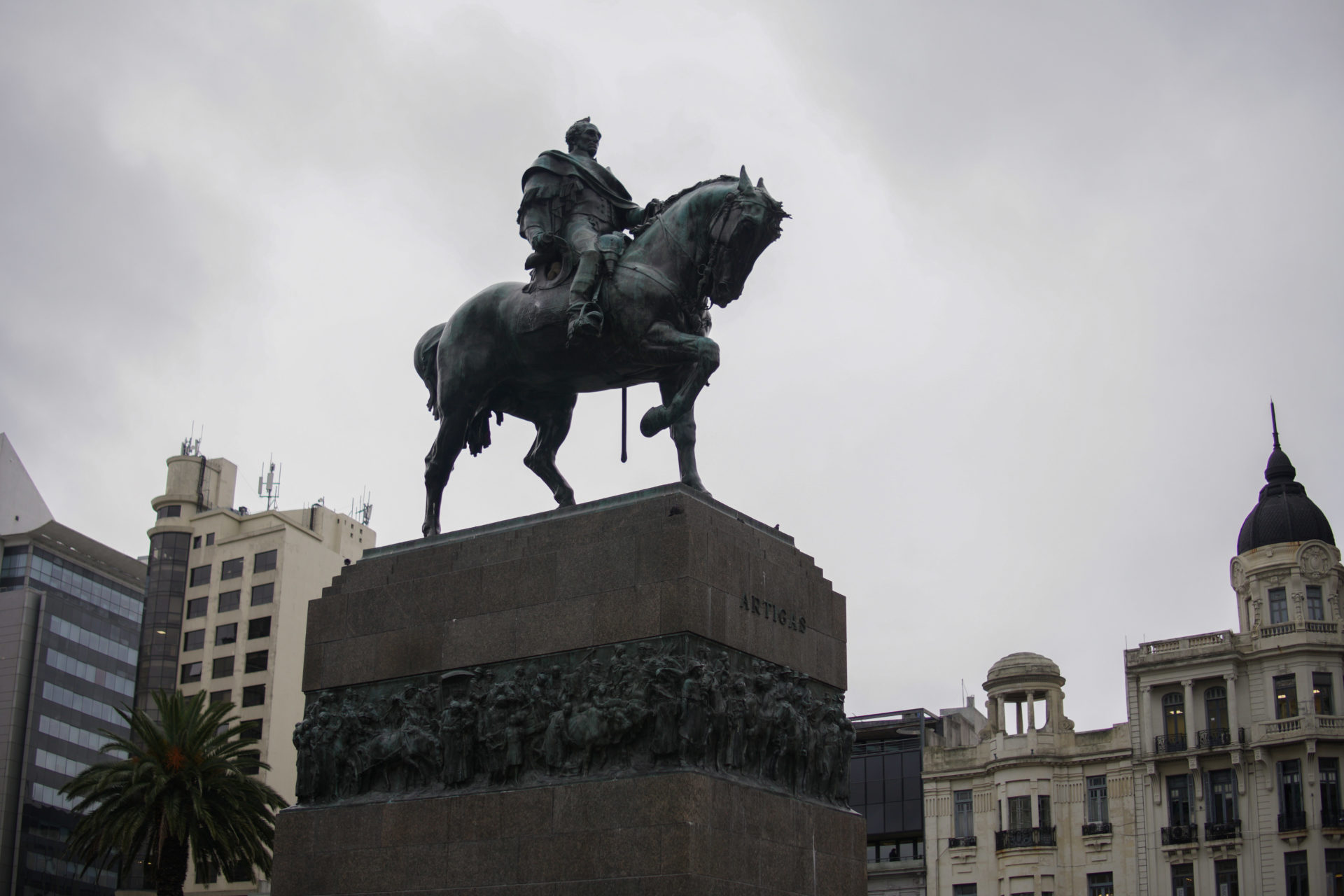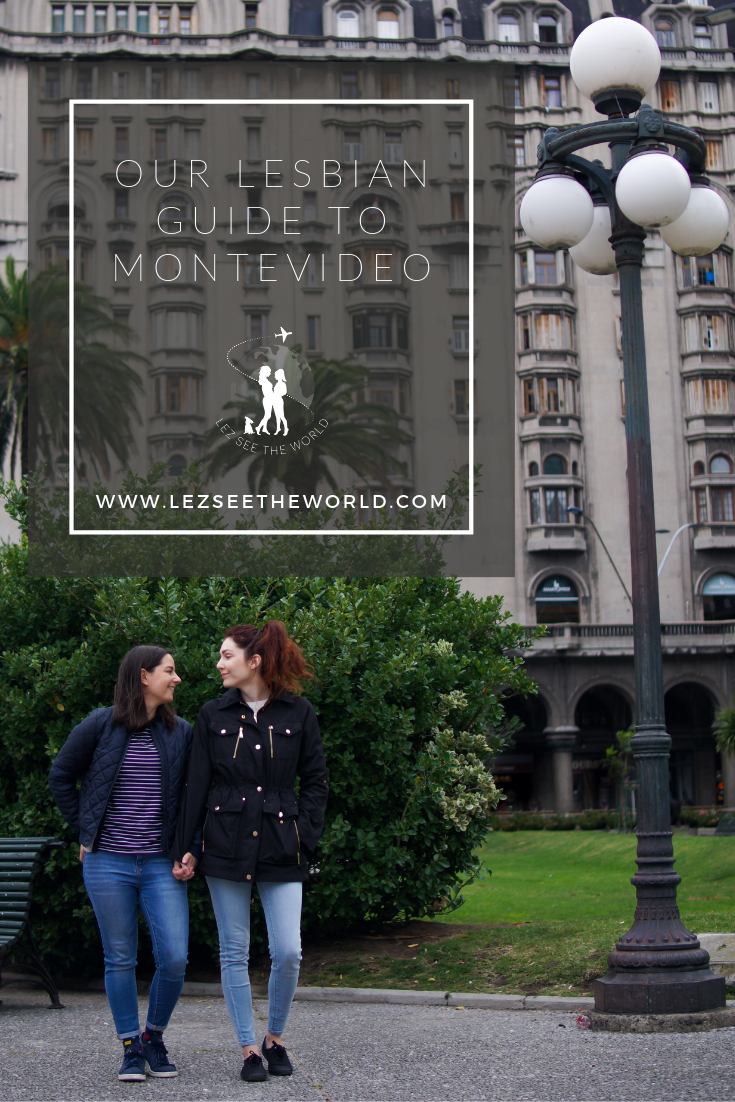Montevideo is an absolute must visit in Uruguay! It’s the country’s capital city, and sits on Montevideo Bay across the water from Argentina. It’s located about two hours east of Colonia del Sacramento, two hours west of Punta del Este (other popular destinations in Uruguay), and is a two hour ferry ride from Buenos Aires, Argentina. Montevideo is the southernmost capital city in the Americas, and is a cultural hub for tech, finance, and entrepreneurial culture. It’s a vibrant city with a charming old town, beautiful waterfront, and gorgeous architecture. We loved wandering around the Ciudad Vieja, and people watching on the Peatonal Sarandi. Montevideo is also very welcoming of LGBTQ+ travellers, and is a safe destination for lesbian women and couples. With progressive laws and a welcoming attitude toward our community, Montevideo is an amazing South American travel destination! If you’re looking to make the most of your time in Uruguay, keep reading for our lesbian guide to Montevideo!
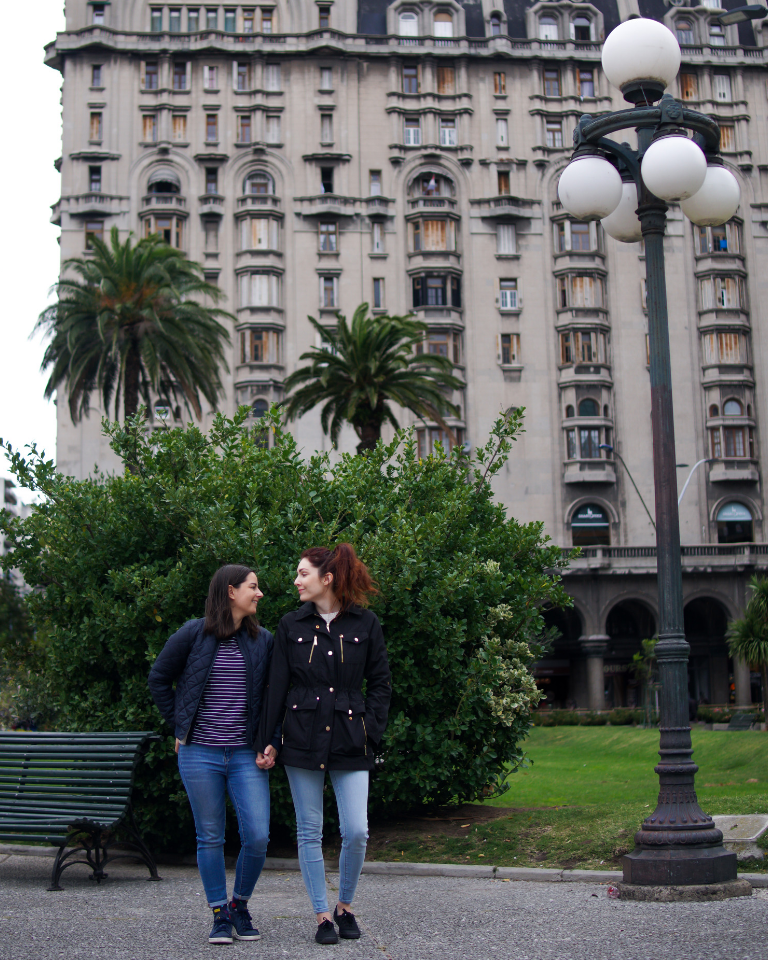
What To Do
Visit the Plaza Independencia
The beautiful Plaza de la Independencia sits in the centre of Montevideo, and is the perfect jumping off point for a day of sight seeing! Separating the city’s downtown from its historic old town, the plaza is a popular attraction with some well known architectural landmarks. Be sure to check out the Gateway of the Citadel, the Artigas Maosoleum, the Palacio Salvo, and the Teatro Solis.
Explore the Ciudad Vieja
Montevideo’s old town is called the Ciudad Vieja, and is a great place to get lost for a day. It has plenty of history and cultural museums if that interests you, as well as a lot of other popular landmarks. Look out for the Metropolitan Cathedral and the Plaza Matriz, as well as some beautiful views of the water from San Juan Gate. There is also a popular historic market called the Mercado del Puerto with plenty of bars and restaurants, as well as a lively nightlife scene with cocktail bars scattered around the area.
Enjoy the Peatonal Sarandi
The historic old town also has an amazing pedestrian zone called the Peatonal Sarandi. It starts at the Ciudadela and runs down to the Rambla. Here you will find plenty of shops, businesses, cafes, and galleries, and it’s a great spot to people watch and enjoy the energy of the city.
Stroll Along the Rambla de Montevideo
This avenue wraps along the coastline of the entire city, and is the longest sidewalk in the world! The promenade is a popular spot for walking, cycling, fishing, and roller skating, and is a beautiful place to enjoy the views of the water. The Rambla is extremely important to Montevideo and has even been proposed as a World Heritage Site. Be sure to spend some time here soaking up the sun.
Explore Downtown Montevideo
Avenida 18 de Julio, is the main commercial street running through the city’s downtown. Named after the date of Uruguay’s first constitution, it’s a very important avenue in Montevideo and a great jumping off point for exploring the city centre.
Check out the City Beaches
If you’re looking to get out and enjoy some of the beautiful beaches Montevideo has to offer, there are plenty of city beaches you can visit! The closest is Playa Ramirez, and a little further out are Pocitos Beach, Playa Verde, Carrasco Beach, Playa del Buceo, and Malvin Beach. A perfect way to escape the city and relax!
Where to Stay
Montevideo is a fairly big city, and deciding where to stay really depends on what you’re looking for. If you decide to go the hotel route, most hotels in Montevideo are located in the downtown area and along the nearby beaches. There are both big chain hotels as well as smaller boutique hotels to fit every price point. If you choose to stay in the downtown area, you’ll be very close to the historic old town and you will definitely find some affordable options. If you want to stay in one of the beautiful areas near the beaches, you’ll be farther away from the city centre but in a really lovely spot by the water. If you’re looking to book hotel accommodations, our favourite tool is Hotels.com. It’s easy to search within a certain price range, and filter for the amenities that you like. They also have a great reward system – for every ten nights you book, you receive one night free. Outside of hotels, there aren’t a lot of accommodation options in Montevideo. We were able to find an Airbnb in the old town for our stay, but there were very few apartments to choose from. If you enjoy using Airbnb like we do, it’s definitely worth taking a look to see what’s available and hopefully you can get lucky like we did! We found a full studio apartment with a kitchen for $36CAD/night. If you’ve never used Airbnb before, click here to set up a profile and save on your first stay!
Where to Eat & Drink
The food scene in Montevideo keeps getting better and better, and is especially geared toward meat eaters. While the culinary offerings are quite diverse, the city is very popular for barbecue and steak. We noticed a small but growing trend in health conscious establishments focused on vegetarian or fully plant-based menus, but not as many as in nearby Buenos Aires. A popular spot for meat eaters is the Mercado del Puerto, a historic port market where you will find plenty of steakhouses. For cozy cafes, try La Farmacia in the old town or Cafe Gourmand and Escaramuza Libros in the city centre. For more upscale dining, Jacinto is a very popular spot for dinner, and Toledo is the place for tapas. If you’re vegan like us, and looking for plant-based options, Natural Food & Market is the perfect spot for lunch, Barra 7 is great for late night eats, and Bambu is a wonderful vegetarian buffet. Montevideo also has a vibrant nightlife scene with plenty of bars and music venues scattered around the city. You really can’t go wrong! Some popular spots include Baar Fun Fun, Patagonia Brewing Co, and the Montevideo Wine Experience. Keep reading for some specifically LGBTQ+ friendly bars and venues.
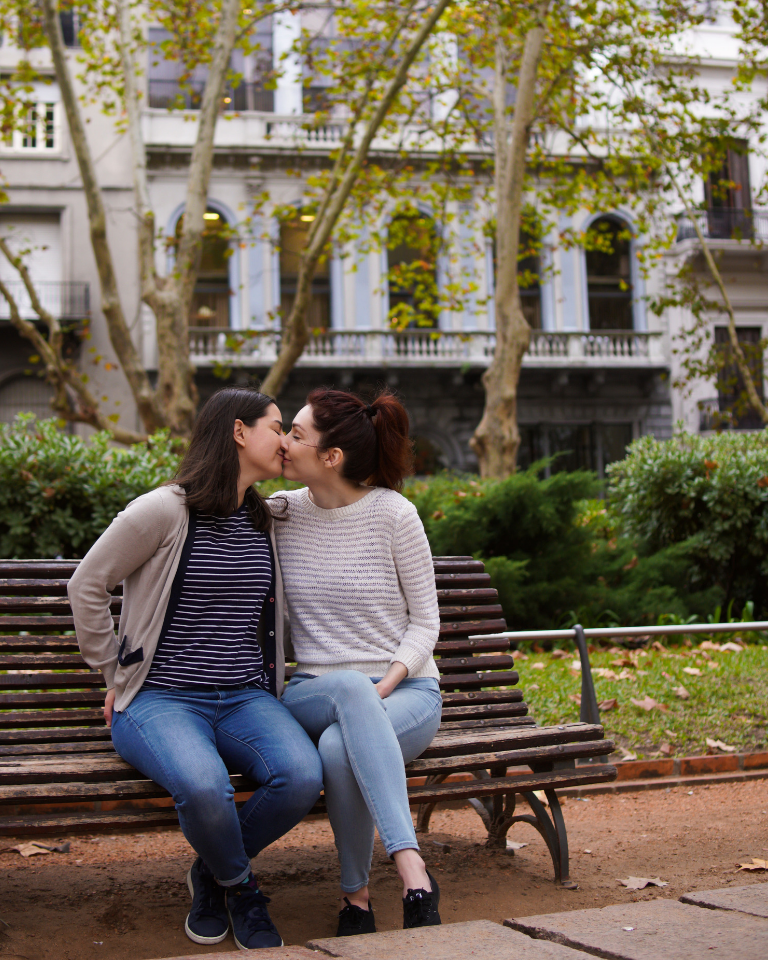
Lesbian Friendly
Uruguay has some of the most progressive LGBTQ+ laws in South America, and is very LGBTQ+ friendly, even by global standards. Click here for more on how lesbian friendly the country of Uruguay is. Montevideo has been called one of the most gay friendly cities in the world, and is very welcoming of travellers. Uruguay legalized same-sex marriage back in 2013, and they’ve had discrimination protections in place for the community since 2003. We felt very safe travelling to Montevideo as a lesbian couple, and had no issues at all while we were exploring the city. We showed affection in public, held hands in the street, took couple photos togethers, and booked an Airbnb with a local host as a married couple. We never felt the need to hide our relationship to stay safe, and everyone we met was very warm to us. Montevideo is one of the few cities in the world with a monument to recognize our community. In 2004, The Plaza of Sexual Diversity was created, featuring a large granite monolith in the shape of a triangle (referencing the pink triangles worn during Nazi persecution). The monolith reads “Honouring diversity is honouring life: Montevideo for the respect of every gender, identity, and sexual orientation”, which is pretty incredible! In terms of a gay scene or “gaybourhood”, the LGBTQ+ establishments in Montevideo are scattered around the city rather than being concentrated in one area. As usual, the gay nightlife is geared toward men, but establishments are still welcoming of gay women. The most popular and well known gay bar/late night venue is called Chains Pub and is located downtown near Plaza de la Independencia. For late night dancing, the most popular gay club/disco is Cain Club, which is also located downtown. Il Tempo is another gay disco located further out of the city centre, close to Playa Ramirez. Montevideo is definitely a lesbian friendly spot to visit in Uruguay. If you’re looking for a welcoming South American city to check out, be sure to add Montevideo to your travel list!
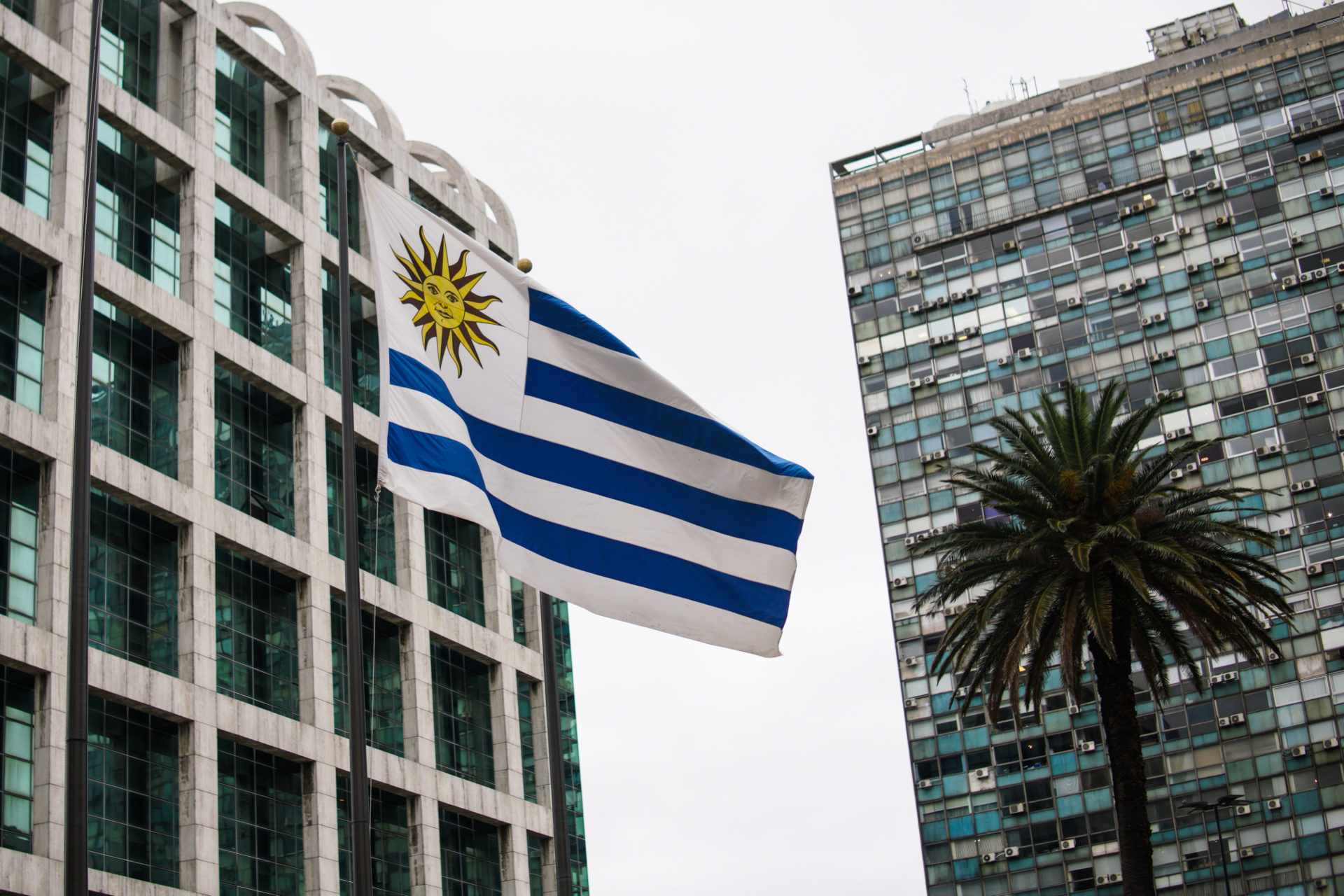
How to Get Here and How to Get Around
Ferry
To get to Montevideo from Buenos Aires, Argentina, you can take a ferry across the Rio de la Plata. There are a few different companies to choose from, but in our opinion the fastest and best option is Buquebus. You can book your tickets online in advance, and they have several sailings per day, so it’s easy to choose a departure that works with your schedule. Buquebus offers two options to get to Montevideo – a direct ferry, and a ferry and bus combination through Colonia. The direct ferry is faster, but more expensive, and the combination offers more sailing times, but will take longer. The direct sailing time from Buenos Aires to Colonia is approximately 2 hours and 15 minutes, and the ferry and bus option will take roughly 4.5 hours. Be sure to arrive at the Puerto Madero terminal in Buenos Aires at least an hour before departure time (the ticket says to arrive two hours before, but nobody actually does). Once you arrive, you can check in with an agent and check any larger pieces of luggage. After check in, you’ll head upstairs and go through exit immigration for Argentina, as well as entry immigration for Uruguay. There is also a nice waiting area with a cafe before you board.
Bus
Getting to and from Montevideo by bus is also very straight forward. If you’re travelling by bus, most likely you’ll be coming from Colonia or Punta Del Este. There are multiple daily bus departures with Turil, Cot and Copsa. If your schedule is flexible, it’s no problem to buy your ticket at the bus station when you arrive, but we’d recommend purchasing your tickets ahead of time online to ensure you have a seat. Urubus is a great website for booking tickets ahead of time, and has multiple languages to choose from for convenience. If it’s a weekend or holiday, then you should definitely book ahead of time, as buses can get busy! The buses are inexpensive, tend to be on time, and have wifi, so the 3 hour trip from Colonia or 2 hour trip from Punta Del Este will be very comfortable.
Walk
The different areas of Montevideo are very walkable, and great to explore on foot. In the old town, the pedestrian street is perfect to stroll along, and the Rambla is a beautiful walk along the water with incredible views. It’s more difficult to walk between the different neighbourhoods in the city, but each area in itself is quite pedestrian friendly.
Bike
We saw a lot of people riding bikes in Montevideo, and it definitely seems like a good way to get around. Just be mindful of the cars on the road, because the drivers tend to drive very close to cyclists. There is a city bike share called Movete, where you can pick up a docked bike and return it to any designated spot in the city.
E-Scooter
The mode of transportation we were most excited to see in the city is the e-scooter network. Montevideo has both Lime and Grin scooters, and they both work the same way. Once you have the app (the Lime app is the same for all of their scooter networks worldwide), you can unlock any scooter you see and take it for a ride. Once you’re finished, simply park the scooter in a spot that’s out of the way, and lock it using your phone. Riding along the Rambla on a scooter is a great way to see the area, although we’d be hesitant to ride everywhere in the city because the cobblestone streets might make for a bumpy ride!
Taxi/Rideshare
Taxis and Ubers are plentiful in the city. Rates are quite a bit higher than in Argentina because of Uruguay’s high gas prices, but they’re still much lower than what we’re used to in North America. Taxis in Uruguay have an evening/Sunday and daytime pricing scale, so expect your rate to be different depending on the time of day.
Public Transportation
There is no subway system in Montevideo, but the bus network is reliable and inexpensive. Buses don’t run late, but there are more taxis on the road after public transportation hours end, so you’ll never be stuck.
Has anyone else fallen in love with Montevideo? Let us know in the comments!


